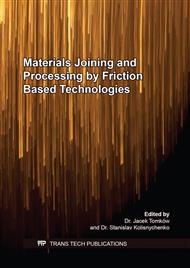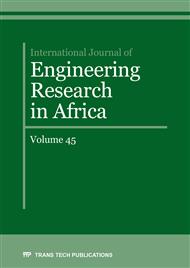[1]
M. Boukraa, N. Lebaal, A. Mataoui, A. Settar, M. Aissani, N. Tala-Ighil, Friction stir welding process improvement through coupling an optimization procedure and three-dimensional transient heat transfer numerical analysis, Journal of Manufacturing Processes 34 (2018) 566-578.
DOI: 10.1016/j.jmapro.2018.07.002
Google Scholar
[2]
J. M. Piccini, H. G. Svoboda, Tool geometry optimization in friction stir spot welding of All-steel Joints, Journal of Manufacturing Processes 26 (2017) 142–154.
DOI: 10.1016/j.jmapro.2017.02.004
Google Scholar
[3]
Q. Chu, W.Y. Li, X.W. Yang, J.J. Shen, A. Vairis, W.Y. Feng, W.B. Wang, Microstructure and mechanical optimization of probeless friction stir spot welded joint of an Al-Li alloy, Journal of Materials Science & Technology 34 (2018) 1739-1746.
DOI: 10.1016/j.jmst.2018.03.009
Google Scholar
[4]
B. Ravi Sankar, P. Umamaheswarrao, Modelling and Optimisation of Friction Stir Welding on AA6061 Alloy, Materials Today: Proceedings 4 (2017) 7448-7456.
DOI: 10.1016/j.matpr.2017.07.076
Google Scholar
[5]
M.V.R. Durga Prasad, Kiran Kumar Namala, Process Parameters Optimization in Friction Stir Welding by ANOVA, Materials Today: Proceedings 5 (2018) 4824-4831.
DOI: 10.1016/j.matpr.2017.12.057
Google Scholar
[6]
O. O. Ojo, E. Taban, E. Kaluc, Friction stir spot welding of aluminum alloys: a recent review, Materials Testing, 2015, 57 (7-8), 609-627.
DOI: 10.3139/120.110752
Google Scholar
[7]
D. Bakavos, Y. Chen, L. Babout, P. Prangnell, Material Interactions in a Novel Pinless Tool Approach to Friction Stir Spot Welding Thin Aluminum Sheet, Metallurgical and Materials Transactions A, 42A (2011), 1266-1281.
DOI: 10.1007/s11661-010-0514-x
Google Scholar
[8]
P. Kah, R. Rajan, J. Martikainen, R. Suoranta, Investigation of weld defects in friction-stir welding and fusion welding of aluminum alloys, International Journal of Mechanical and Materials Engineering 10 (2015), 26 DOI 10.1186/s40712-015-0053-8.
DOI: 10.1186/s40712-015-0053-8
Google Scholar
[9]
V. Ebrahimzadeh, M. Paidar, M. A. Safarkhanian, O. Oladimeji Ojo, Orbital friction stir lap welding of AA5456-H321/AA5456-O aluminum alloys under varied parameters, The International Journal of Advanced Manufacturing Technology, 2018, DOI 10.1007/s00170-018-1679-5.
DOI: 10.1007/s00170-018-1679-5
Google Scholar
[10]
Q. Yang, S. Mironov, Y.S. Sato, K. Okamoto, Material flow during friction stir spot welding, Materials Science and Engineering A, 527 (2010), 4389-4398.
DOI: 10.1016/j.msea.2010.03.082
Google Scholar
[11]
R. Fonda, A. Reynolds, C.R. Feng, K. Kniplin. G D. Rowenhorst, Material Flow in Friction Stir Welds, Metallurgical and materials transactions A, 44A (2013), 337-344.
DOI: 10.1007/s11661-012-1460-6
Google Scholar
[12]
Y.-C. Lin, J.-J. Liu, J.-N. Chen, Material Flow Tracking for Various Tool Geometries During the Friction Stir Spot Welding Process, Journal of Materials Engineering and Performance, 22 (2013), 3674-3683.
DOI: 10.1007/s11665-013-0680-2
Google Scholar
[13]
Q. Chu, X.W. Yang, W.Y. Li, Y. Zhang, T. Lu, A. Vairis, W.B. Wang, On visualizing material flow and precipitate evolution during probeless friction stir spot welding of an Al-Li alloy, Materials Characterization, 144 (2018), 336-344.
DOI: 10.1016/j.matchar.2018.07.026
Google Scholar
[14]
O. O. Ojo, E. Taban, E. Kaluc, Effect of residual Alclad on friction stir spot welds of AA2219 alloys, Materials Testing, 60 (2018), 979-988.
DOI: 10.3139/120.111245
Google Scholar
[15]
K.W. Zeng, Z.-M. Su, S.M. Luo, P.-C. Lin, M.T. Dong, T. Tang, B. Huang, Removing approach for flashes of friction stir spot welds, Journal of Materials Processing Technology, 213 (2013) 1725– 1733.
DOI: 10.1016/j.jmatprotec.2013.03.019
Google Scholar
[16]
F. Hasan, J. Iqbal, F. Ahmed, Stress corrosion failure of high-pressure gas pipeline. Engineering Failure Analysis 14 (2007), 801–809.
DOI: 10.1016/j.engfailanal.2006.11.002
Google Scholar
[17]
S. Kainuma, H. Katsuki, I. Iwai, M. Kumagai, Evaluation of fatigue strength of friction stir butt-welded aluminum alloy joints inclined to applied cyclic stress, International Journal of Fatigue 30 (2008), 870–876.
DOI: 10.1016/j.ijfatigue.2007.06.007
Google Scholar
[18]
S. Sudhagar, M. Sakthivel, P.J. Mathew, S. Ajith Arul Daniel, A Multi-Criteria Decision Making approach for process improvement in Friction Stir Welding of Aluminium Alloy, Measurement, 108 (2017), 1-8.
DOI: 10.1016/j.measurement.2017.05.023
Google Scholar
[19]
S. Shanavas, J. Edwin Raja Dhas, Parametric optimization of friction stir welding parameters of marine grade aluminum alloy using response surface methodology, Trans. Nonferrous Met. Soc. China, 27 (2017) 2334−2344.
DOI: 10.1016/s1003-6326(17)60259-0
Google Scholar
[20]
A. Kumar, M K Khurana, G. Singh, Modeling and Optimization of Friction Stir Welding Process Parameters for Dissimilar Aluminium Alloys, Materials Today: Proceedings 5 (2018) 25440–25449.
DOI: 10.1016/j.matpr.2018.10.349
Google Scholar
[21]
N. Arun Babu, B.Balu naik, B.Ravi, G.Rajkumar, Process Parameter optimization For Producing AA7075/WC composites by Friction stir welding, Materials Today: Proceedings 5 (2018) 18992–18999.
DOI: 10.1016/j.matpr.2018.06.250
Google Scholar
[22]
R. K. Kesharwani, S. K. Panda, S. K. Pal, Multi-Objective Optimization of Friction Stir Welding Parameters for Joining of Two Dissimilar Thin Aluminum Sheets, Procedia Materials Science, 6 (2014) 178 – 187.
DOI: 10.1016/j.mspro.2014.07.022
Google Scholar
[23]
A.K. Pattanaik, S. Pradhan, S.N. Panda, D.K. Bagal, K. Pal, D. Patnaik, Effect of Process Parameters on Friction Stir Spot Welding Using Grey Based Taguchi Methodology, Materials Today: Proceedings, 5 (2018) 12098–12102.
DOI: 10.1016/j.matpr.2018.02.186
Google Scholar
[24]
B. Magamai Radj, T. Senthivelan, Analysis of mechanical properties on friction stir welded magnesium alloy by applying Taguchi Grey based approach, Materials Today: Proceedings, 5 (2018) 8025–8032.
DOI: 10.1016/j.matpr.2017.11.487
Google Scholar
[25]
P. K. Sahu, S. Pal, Multi-response optimization of process parameters in friction stir welded AM20 magnesium alloy by Taguchi grey relational analysis, Journal of Magnesium and Alloys, 3 (2015) 36-46.
DOI: 10.1016/j.jma.2014.12.002
Google Scholar
[26]
O. O. Ojo, E. Taban, Hybrid multi-response optimization of friction stir spot welds: failure load, effective bonded size, and flash volume as responses, Sådhanå 43 (2018), 1-13.
DOI: 10.1007/s12046-018-0882-2
Google Scholar
[27]
P. K. Farayibi, Multi-Objective Optimisation of Laser Deposition of Metal Matrix Composites for Surface Coating Using Principal Component Analysis, International Journal of Engineering Research in Africa, 40 (2018), 9-21.
DOI: 10.4028/www.scientific.net/jera.40.9
Google Scholar
[28]
K. N. Wakchaure, A. G. Thakur, Vijay Gadakh, A. Kumar, Multi-Objective Optimization of Friction Stir Welding of Aluminium Alloy 6082-T6 Using hybrid Taguchi-Grey Relation Analysis- ANN Method, Materials Today: Proceedings, 5 (2018) 7150–7159.
DOI: 10.1016/j.matpr.2017.11.380
Google Scholar
[29]
M. Akbari, M. H. Shojaeefard, P. Asadi, A. Khalkhali, Hybrid multi-objective optimization of microstructural and mechanical properties of B4C/A356 composites fabricated by FSP using TOPSIS and modified NSGA-II, Trans. Nonferrous Met. Soc. China, 27(2017) 2317−2333.
DOI: 10.1016/s1003-6326(17)60258-9
Google Scholar
[30]
P. Periyasamy, B. Mohan, V. Balasubramanian, S. Rajakumar, S. Venugopal, Multi-objective optimization of friction stir welding parameters using desirability approach to join Al/SiCp metal matrix composites, Trans. Nonferrous Met. Soc. China, 23(2013) 942-955.
DOI: 10.1016/s1003-6326(13)62551-0
Google Scholar
[31]
M Gomathisankar, M Gangatharan, P Pitchipoo, A Novel Optimization of Friction Stir Welding Process Parameters on Aluminum Alloy 6061-T6, Materials Today: Proceedings, 5 (2018) 14397–14404.
DOI: 10.1016/j.matpr.2018.03.025
Google Scholar
[32]
A Heidarzadeh, RV Barenji, V Khalili, G Güleryüz, Optimizing the friction stir welding of the α/β brass plates to obtain the highest strength and elongation, Vacuum, 159 (2018), 152-160.
DOI: 10.1016/j.vacuum.2018.10.036
Google Scholar
[33]
K. Jangra, S. Grover, A. Aggarwal, Optimization of multi machining characteristics in WEDM of WC-5.3%Co composite using integrated approach of Taguchi, GRA and entropy method, Front. Mech. Eng., 7(2012), 288–299.
DOI: 10.1007/s11465-012-0333-4
Google Scholar
[34]
R. Rao, V. Yadava, Multi-objective optimization of Nd:YAG laser cutting of thin superalloy sheet using grey relational analysis with entropy measurement, Optics & Laser Technology 41 (2009), 922–930.
DOI: 10.1016/j.optlastec.2009.03.008
Google Scholar
[35]
J. A. Ray, Multi-Objective Optimization of Green EDM: An Integrated Theory, J. Inst. Eng. India Ser. C, 96 (2015), 41–47.
DOI: 10.1007/s40032-014-0142-0
Google Scholar
[36]
S. H. Mahdaviani, M. Parvari, D. Soudbar, Simultaneous multi-objective optimization of a new promoted ethylene dimerization catalyst using grey relational analysis and entropy measurement, Korean J. Chem. Eng., 33(2016), 423-437.
DOI: 10.1007/s11814-015-0158-z
Google Scholar
[37]
K. Cai, D. Wang, Optimizing the design of automotive S-rail using grey relational analysis coupled with grey entropy measurement to improve crashworthiness, Struct Multidisc Optim, 56 (2017), 1539-1553.
DOI: 10.1007/s00158-017-1728-y
Google Scholar
[38]
S.-C. Huang, T.-P. Dao, Multi-objective Optimal Design of a 2-DOF Flexure-Based Mechanism Using Hybrid Approach of Grey-Taguchi Coupled Response Surface Methodology and Entropy Measurement, Arab J Sci Eng, 41 (2016), 5215-5231.
DOI: 10.1007/s13369-016-2242-z
Google Scholar
[39]
W.Y. Li, Q. Chu, X.W. Yang, J.J. Shen, A. Vairis, W.B. Wang, Microstructure and morphology evolution of probeless friction stir spot welded joints of aluminum alloy, Journal of Materials Processing Tech., 252 (2018), 69-80.
DOI: 10.1016/j.jmatprotec.2017.09.003
Google Scholar
[40]
Q. Chua, X.W. Yang, W.Y. Li, A. Vairis, W.B. Wang, Numerical analysis of material flow in the probeless friction stir spot welding based on Coupled Eulerian-Lagrangian approach, Journal of Manufacturing Processes, 36 (2018), 181-187.
DOI: 10.1016/j.jmapro.2018.10.013
Google Scholar
[41]
J. Shen, S.B.M. Lage, U. F.H. Suhuddin, C. Bolfarini, J. F. Dos Santos, Texture Development and Material Flow Behavior During Refill Friction Stir Spot Welding of AlMgSc, Metallurgical and Materials Transactions A, 49 (2017), 241-254.
DOI: 10.1007/s11661-017-4381-6
Google Scholar
[42]
A. Reilly, H. Shercliff, Y. Chen, P. Prangnell, Modelling and visualization of material flow in friction stir spot welding, Journal of Materials Processing Technology, 225(2018), 473-484.
DOI: 10.1016/j.jmatprotec.2015.06.021
Google Scholar
[43]
R. Sarkar, T.K. Pal, M. Shome, Material Flow and Intermixing during Friction Stir Spot Welding of Steel, Journal of Materials Processing Technology, 227 (2016), 96-109.
DOI: 10.1016/j.jmatprotec.2015.08.006
Google Scholar
[46]
O. O. Oladimeji, E. Taban, E. Kaluc, Understanding the role of welding parameters and tool profile on the morphology and properties of expelled flash of spot welds, Materials and Design, 108 (2016), 518-528.
DOI: 10.1016/j.matdes.2016.07.013
Google Scholar
[47]
Wen K L, Chang T C, You M L, The grey entropy and its application in weighting analysis. In: Proceedings of IEEE International Conference on System, Man and Cybernetics, 2 (1998), 1842–1844.
DOI: 10.1109/icsmc.1998.728163
Google Scholar



